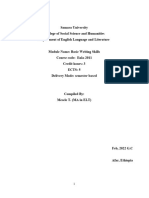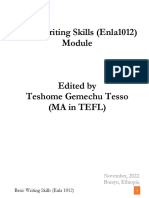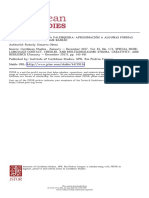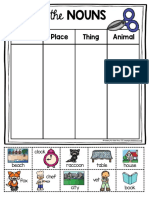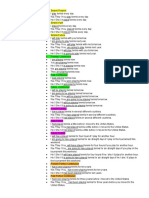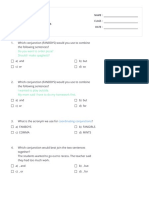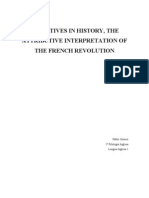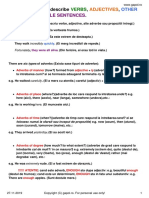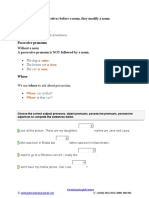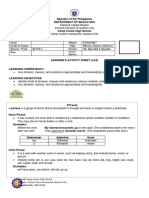Sentence
A sentence is a group of words that expresses a complete thought.
It usually contains a subject (who or what the sentence is about) and a predicate (what is said about the
subject). A sentence must begin with a capital letter and end with a full stop (.), question mark (?) or
exclamation mark (!).
Example:
• The students are studying in the library.
• Stone walls do not make a prison.
This is a complete thought with a subject (The students) and a predicate (are studying in the library).
• A complete sentence must have at least one subject and one verb.
• It should express a clear and complete idea, not just a fragment.
Phrase
A phrase is a group of words that work together as a unit in a sentence but do not have both a subject
and a verb. Because of this, a phrase cannot stand alone as a complete sentence. It only gives part of
an idea.
Think of a phrase as a “piece” of a sentence, not the whole sentence.
• A phrase does not express a complete thought.
• It may contain a noun or a verb, but not both as a subject + predicate combination.
• Phrases function as parts of speech (noun, adjective, adverb, etc.) in a sentence.
Clauses
A clause is a group of words with a subject and a verb.
• Independent Clause – expresses a complete idea; can stand alone as a sentence.
o She is reading a novel.
o The dog barked loudly.
o We went home after the class.
• Dependent Clause – has a subject and a verb but cannot stand alone; needs an independent
clause.
o Because she was tired
o When the rain stopped
o Although he tried his best
Sentences are built from clauses. A simple sentence has one independent clause, while complex or
compound sentences combine more than one clause.
Clauses must contain a verb, or else we class them as fragments. The following is a clause:
• They watched the sunset together.
But this is a fragment:
• What a sunset!
1
� 1. Parts of Sentence
a) Subject
• The noun or pronoun that performs the action or is described in the sentence.
Examples:
• Ali plays cricket.
• The children are singing.
• The dog barked loudly.
b) Predicate
• The part of the sentence that contains the verb and tells what the subject does or is.
Examples:
• Ali plays cricket.
• The children are singing.
• The dog barked loudly.
c) Object
• A noun or pronoun that receives the action of the verb. Objects can be direct or indirect.
i. Direct Object: Answers “what?” or “whom?” after the verb.
• She wrote a letter. (direct object) �She wrote what? A letter. "Letter" is the direct object.
• The dog ate the bone. � The dog ate what? The bone. "Bone" is the direct
• He helped her. � He helped whom? Her. "Her" is the direct object.
ii. Indirect Object: Tells “to whom/for whom?” something is done.
• He gave his friend a gift. � He gave a gift to whom? His friend. "Friend" is the indirect
object, and "gift" is the direct object.
• She gave him the bone. � She gave the bone to whom? Him. "Him" is the indirect object,
and "bone" is the direct object.
• I bought myself a new coat." � I bought a new coat for whom? Myself. "Myself" is the
indirect object, and "coat" is the direct object.
d) Complement
• A complement is a word or phrase that completes the meaning of a verb and provides more
information about the subject or object of a sentence.
i. Subject Complement (S C): A subject complement is a noun, pronoun, or adjective that follows a
linking verb and renames or describes the subject of the sentence. (after linking verbs: am, is, are,
was, were, seem, become, and look).
Examples:
• She is a doctor. � The noun "doctor" renames the subject "she." "Doctor" is the subject
complement.
2
� • He looks tired. � The adjective "tired" describes the subject "he." "Tired" is the subject
complement.
• The cake tastes delicious. � The adjective "delicious" describes the subject "cake."
"Delicious" is the subject complement.
ii. Object Complement (O C): It provides additional information about the direct object.
Examples:
• They elected him president. � The noun "president" renames the direct object "him."
"President" is the object complement.
• The news made her happy. � The adjective "happy" describes the direct object "her."
"Happy" is the object complement.
• He painted the wall blue. � The adjective "blue" describes the direct object "wall." "Blue"
is the object complement.
2. Basic Sentence Patterns
English sentences follow predictable patterns. Common ones include:
1. Subject-Verb (S-V)
This is the simplest pattern, featuring a subject (the person or thing doing the action) and a verb (the
action). It represents a complete thought.
• The dog barked.
• Birds fly.
• He ran.
2. Subject-Verb-Object (S-V-O)
This pattern includes a direct object which receives the action of the verb.
• She ate a sandwich.
• The student read the book.
• He kicked the ball.
3. S + V + IO + DO
o Subject + Verb + Indirect Object + Direct Object
Example: She gave him a gift.
4. Subject-Verb-Adjective (S-V-Adj)
This pattern uses a linking verb (like is, are, was, were, seems, feels) to connect the subject to an
adjective that describes it.
• The flowers are beautiful.
• He seems happy.
• The food smells delicious.
3
� 5. Subject-Verb-Adverb (S-V-Adv)
In this pattern, a linking verb connects the subject to an adverb that tells where, when, or how the
subject is.
• The meeting is today.
• My keys are in the car.
• She was here.
6. Subject-Verb-Noun (S-V-N)
This pattern uses a linking verb to connect the subject to another noun that renames or identifies the
subject. This second noun is called the predicate noun.
• My mother is a doctor.
• The city became a ghost town.
• He is a writer.
Types of Sentences
Sentences can be categorized based on their function:
1. Declarative Sentence.
2. Interrogative Sentence.
3. Imperative Sentence.
4. Exclamatory Sentence.
5. Optative Sentence.
1. Declarative Sentence / Assertive Sentence
Sentences which state things the way they are. They express facts, actions and happenings. There are
two kinds of a declarative sentence.
i. Affirmative Sentence
ii. Negative Sentence
Assertive or declarative sentences end with a full stop.
For Example
• The sky is blue.
• Sahiwal is a peaceful place.
• She has no car.
2. Interrogative Sentences/ questions
These are those statements which are used to ask questions. There are two kinds of interrogative
sentences –
i. Single Interrogative
ii. Double Interrogative
Single Interrogative sentences start with an auxiliary verb. For instance –
• Are you going to offer prayer?
• Can he solve this problem?
And double interrogative sentences start with Wh. For instance –
• Why are you so happy?
4
� • Where has your father been for so long?
All the interrogative sentences end with a question mark (?).
3. Imperative sentences/Commands
These sentences express requests, command, suggestions etc. They are both positive and negative.
Imperative sentences end with a full stop. For instance –
• Come here. (Command/Suggestion)
• Come here, please. (Request)
• Don’t sit there. (Command/suggestion)
4. Exclamatory sentences:
These sentences express exclamations. They express sudden feelings and emotions like joy, sorrow,
surprise, anger etc. Exclamatory sentences end with exclamation marks. For instance –
• Wow! The sky is blue.
• What a peaceful county Finland is!
• Hurrah! we have won the match.
5. Optative Sentence
These sentence express wishes, prayers, blessings and curses. Optative sentences end with an
exclamation mark. For instance-
• Good morning!
• May you live long!
• May you go to hell!
• Happy birthday!
• May the almighty help in this tragedy!
• Wish you a very successful married life.
• Wish you a happy journey together.
• May your team win the match!
A good writer must be able to use variety of sentences in any piece of writing. Variety gives a piece of
writing a fast pace and makes it interesting to read.
Structural classification of the sentence
There are four basic structures of the sentence. They are,
• Simple sentence
• Compound sentence
• Complex sentence
• Compound-Complex sentence or multiple sentence
5
�1. Simple Sentence
A simple sentence contains a single independent clause. It expresses just one main idea. It contains a
subject and a predicate, examples:
• I do not like dogs.
• Ayo is my best friend.
• She is my friend.
• Usama rode his bike to university.
• Who is your best friend?
• She ate her lunch.
2. Compound Sentence
A compound sentence contains two independent clauses that are joined by a coordinating conjunction
(e.g., but, or, so, yet, etc.), examples:
• I do not like dogs and my sister does not like cats.
• You can write on paper, or you can use your computer.
• The lecture was interesting, yet the students complained about the time.
• She wanted to go on vacation, so she saved up her money.
• I like apples, but my sister loves bananas.
3. Complex Sentence
This contains an independent clause with one or more dependent clauses, that is, one main idea and
two or more supporting ideas joined with subordinating conjunctions (e.g., that, because, while,
although, if, etc.), examples:
• She did her homework while her father cooked dinner.
• You can write on paper, although a computer is better if you want to correct mistakes.
• I do not like dogs that bark at me when I pass them.
• She went to class even though she was sick.
• While I enjoy classical music, I prefer rock and roll because I play the drums.
4. Compound-complex or Multiple-sentence
This sentence contains two or more independent clauses and one dependent clause, examples:
• I do not like dogs and my sister does not like cats because they make her sneeze.
• You can write on paper but using a computer is better as you can easily correct your mistakes.
• Because the rain started, we went inside, and we played a board game.
• I like the new house that you bought, but it's too far from my office.
• She finished her homework, and she watched a movie after she ate dinner.























